Latest reviews
Life is Strange (reviews) established the team at Dontnod Entertainment as talented storytellers and worldbuilders. The game was a joy to explore and offered meaningful player choices that elevated it above the status of mere “walking simulator”. The story it told had a definitive ending; what, then, could a sequel have to offer?
While Life is Strange 2 occupies the same universe and is structured in a similar episodic format, it tells a completely new story, setting the series up as an anthology—think Fargo or True Detective, not Stranger Things.
The second season is about a 16-year-old kid named Sean Diaz and his little brother Daniel. After a traumatic incident, Sean and Daniel find themselves running away from home and wanted by the police.
As the player, you control Sean’s actions and define the kind of relationship you will have with your brother, and with the world you both inhabit. Will you and Daniel steal food to survive, or beg for scraps? Will you attack those who wrong you, or forgive them? Will you trust in the kindness of family and strangers, or face the odds on your own?
The story takes place in America under Donald Trump, but the writers make a point to include moments of love and tenderness alongside the darkness of racism and prejudice that Trump represents.
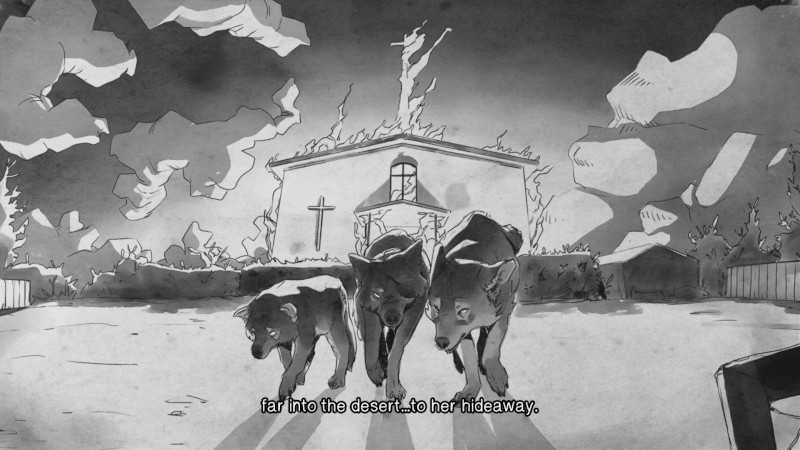
A story told by Sean to his little brother sums up the events so far at the beginning of each episode. In the story, Sean and Daniel are “wolf brothers”. (Credit: Dontnod Entertainment. Fair use.)
Warning: The text below contains spoilers.
Like the first season, Life is Strange 2 has a supernatural element. Early in the game, it becomes clear that Daniel possesses significant telekinetic powers. As the player, you coach Daniel on when and whether to use his powers, but you do not control them directly, and your choices are not reversible.
Life is Strange 2 improves on the first game’s graphics, which is especially noticeable during the sequences where you explore natural environments like the forests of Washington and Oregon, or a canyon in Arizona. Like the first season, the game is fully voice-acted. Unfortunately, I felt that Gonzalo Martin (Sean Diaz) often overacted his part, which is significant because he’s the main voice you’ll be hearing throughout the game.
Besides making choices and occasionally solving small inventory-based puzzles, you also get to collect souvenirs on the road, which you can inspect in your backpack later. Moreover, Sean Diaz is an aspiring artist, and at various moments you can sit down and draw in your sketchbook. You don’t directly control the pen, but you can choose between different ways Sean sees the world: Is a room you’re trapped in a prison, or can you already see a stairway to freedom?
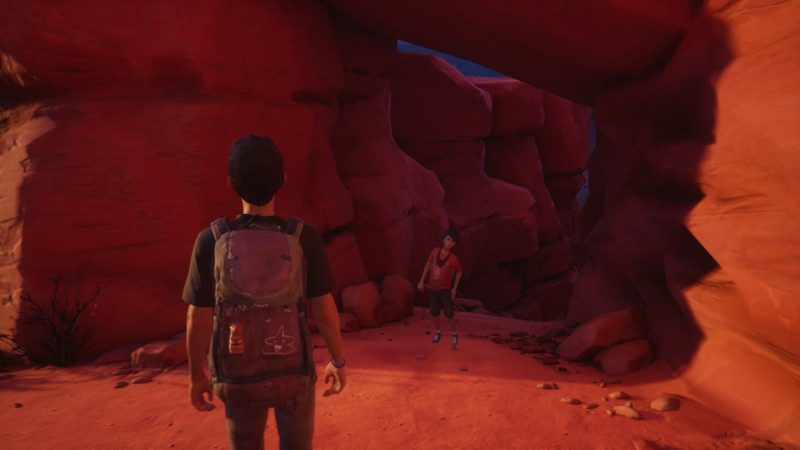
In the last episode, you and Daniel briefly explore a canyon in Arizona, showcasing the game’s significantly improved graphics. (Credit: Dontnod Entertainment. Fair use.)
The first Life is Strange ultimately presented the player with a choice between two very different endings. Life is Strange 2 builds towards a similar choice, but the endings depend not just on that one decision, but on the cumulative effect of your actions so far. For my playthrough, this worked really well. I felt that the ending corresponded beautifully to how I had chosen to act as Sean. That’s a rare feat for a game.
I enjoyed the game, and recommend it. Like the first title, it depends heavily on the chemistry between two characters—in this case, Sean and Daniel. I did not find those characters quite as compelling as Max and Chloe in the first game, partially due to the voice acting, and partially because playing out an at times strained relationship between two siblings is just more emotionally exhausting.
I would rate the game 4.5 stars, rounded up because the team at Dontnod clearly poured their hearts and souls into this game. If you’re looking for mindless escapism completely detached from reality, this is not the game to pick, but if you invest yourself in its story and characters, the game rewards you with a narrative arc that truly feels like you’ve made it your own.
Va a Cambiar tu Manera de Pensar
Comer sushi podría ser nada más una manera de comer algo exótico, o una rutina, pero el sushi de Yokomo Sushi va a cambiar tu manera de pensar acerca de lo que el sushi puede ser.

Ética: No, ellos no van a “nada más” darte tu bendito sushi…
Para empezar, cuando ves su logo y su imagen, podrías pensar que Yokomo Sushi es un negocio más, donde una persona o un grupo de personas quieren armar un negocio con la sencilla meta de hacer dinero. Esa es una de las consecuencias de vivir en un mundo capitalista (especialmente neoliberal). En ese triste mundo, consideraciones como el buen trato y paga a los trabajadores o incluso lo sostenible que un negocio es, depende de lo que los consumidores pidan. Esto asume que el mercado viene primero y la ética después. Como si fuéramos robots. Como si los valores no valieran. Como si el mundo no fuera a hacerse lata en las próximas décadas por nuestras emisiones de CO2 (por decirlo con cautela, porque si queremos ser más explícitos, reconoceríamos que el problema incluye nuestra organización social), lo cual viene a calentar el mundo. Y todo esto nos trae a Yokomo.
Yokomo apenas abrió hacía sus entregas en el terrible duroport (es terrible porque no es para nada viable reciclarlo y toma miles de años en descomponerse, metiéndose en tus océanos y volviéndose tóxico para tu cuerpo). Mi familia se puso en contacto con ellos para dejarles ver el enorme problema que es usarlo. Y vaya vaya, nos respondieron. Hicieron un cambio excelente. Ahora, entregan su comida en empaques de cartón, bolsas biodegradables, y papel de cocina. Me encanta pedir el sushi y ver que no solamente nos escucharon, sino que nos siguen escuchando años después. En este sentido, Yokomo Sushi es un ejemplo para el mercado guatemalteco.
Por otra parte, dado que “Guate es chiquita” y la Marro es un colegio donde todos nos conocemos, sabemos un poco sobre cómo tratan a sus empleados. Y lo que escuchamos fue gratificante. Los trabajadores son tratados bien. Esto me reconforta. Es parte de lo que tomo en cuenta cuando me pregunto si quiero desayunar un McMuffin en McDonald’s con su terrible historia de maltratar a sus trabajadores, una hamburguesa de Wendy’s con su asquerosamente corrupto Gustavo Alejos, o tal vez un sushi de Yokomo. Esto último puede sonar absurdo, pero cuando quiero pedir comida de verdad que lo pienso.
Esto nos trae al siguiente punto
… ¿pero a qué costo?
Esto va a variar muchísimo. Estamos hablando de uno de los países más pobres del planeta tierra. Un país con desnutrición crónica. Tanta, que 50% de los niños chapines no crecen por estar desnutridos. Entonces, si eres un guatemalteco promedio, sería completamente absurdo, un chiste enorme, pedir Yokomo.
Pero, sabiendo eso, de manera muy incómoda puedo decirles que gano suficiente dinero como para poder pedir Yokomo sin problema. Eso no significa que lo pida a la loca. Muchas veces comparo lo que cuesta lo que como con lo que otros comen. Y por esa razón pido las cosas más baratas. Eso a veces significa comer Mc. Otras veces significa pedir, de Yokomo, los rollos más baratos. Pido El Salmón. O el KaliKomo. Ambos sólidos rollos. Pero a veces reconozco que es sencillamente una verdad que yo solito, con mi dinero, no voy a cambiar las relaciones sociales de Guatemala. Y termino pidiendo el QuesoKomo, o el Kani Explosion. Y a la madre. A la madre. A la madre.
Los rollos elaborados son demasiado ricos
¿Piensas que los rollos solamente son ricos si están fríos? Piensa en lo inferiores que son muchas cosas cuando son frías. Piensa en el pan. En el pollo. En las papas fritas. Cada una de esas cosas se vuelve tantas veces mejor cuando está caliente. ¿El sushi es la excepción?
Hay que tener cuidado. No se puede calentar un rollo a la loca. Hay que hacerlo bien. Y Yokomo lo logra con su QuesoKomo y el Kani Explosion. Entonces, ¿el sushi es la excepción?
No. Para nada. No si Yokomo te hace el sushi. Y eso es parte de por qué pido Yokomo. Sus rollos más elaborados son explosiones de sabores. La Kani Salad en el Kani Explosion es demasiado rica. La salsa preparada que la acompaña es una idea genial, y realmente mejora todo lo que toca. El Queso Komo caliente es bajado del cielo. Uff. ¡Quiero comerme uno ahora!
Conclusión
Si recuerdan, yo les dije que Yokomo era excepcional porque no era una empresa que nada más buscaba el asqueroso objetivo de maximizar ganancias. Sino que además, era responsable en cuanto a el trato a trabajadores y su responsabilidad ambiental. Claro que la parte ambiental parece haber sido en respuesta a la demanda consumidora en vez de su propia iniciativa. Por lo menos ahora sé que ellos se informan, saben buscar la ciencia confiable y se preocupan por los demás. Eso me es suficiente.
Pero ellos van más allá. Sus rollos elaborados son excelentes. Sí, son caros y me siento culpable cuando los pido porque vivimos en un país viciosamente desigual y pobre. Pero a la vez, los rollos y sus salsas preparadas son excelentes.
Helen Sjöholm gör en fantastisk artistinsats i sin “skrotorkester”-version av Hellmans poplåt. Röstresurserna är som vanligt enastående och utstrålningen likaså. Arrangemanget håller en på spetsen och de ovanliga instrumentvalen håller en på tåspetsarna hela tiden. Framförallt hanteras bastuban av Kalle Jakobsson skickligt.
Small biological miracles occur all around us. Birds, dragonflies, moths, or butterflies you observe during a hiking trip may be in the middle of migrations that require them to navigate distances of hundreds or even thousands of kilometers. A honeybee feeding on the nectar of a sunflower in your backyard may later share its distance and direction with the hive by way of a complicated waggle dance.
In an age where many of us rely on computers and satellites to tell us where to go when we travel off our beaten paths, these feats of animal navigation are all the more impressive. To find their way, animals rely on the sun, the moon, and the stars; on sound, sight and smell; even on superpowers we lack, like the detection of subtle variations in the intensity, inclination, and declination of the Earth’s geomagnetic field.
In Supernavigators, David Barrie reveals the navigational tools and methods utilized by animals ranging from insects to humpback whales. He compares them with navigation strategies employed by humans, from Polynesian voyagers to the Long Range Desert Group, a British reconnaissance and raiding unit in World War II.
Barrie is no stranger to the subject of navigation. His previous book, Sextant, focused on the use of the titular instrument for celestial navigation, and the author is an experienced sailor. Like many popular science books, Supernavigators is not just about what we know, but also how we know it. Barrie visited and interviewed many scientists, and he even accompanied a scientific expedition studying the long-distance seasonal migrations of bogong moths.
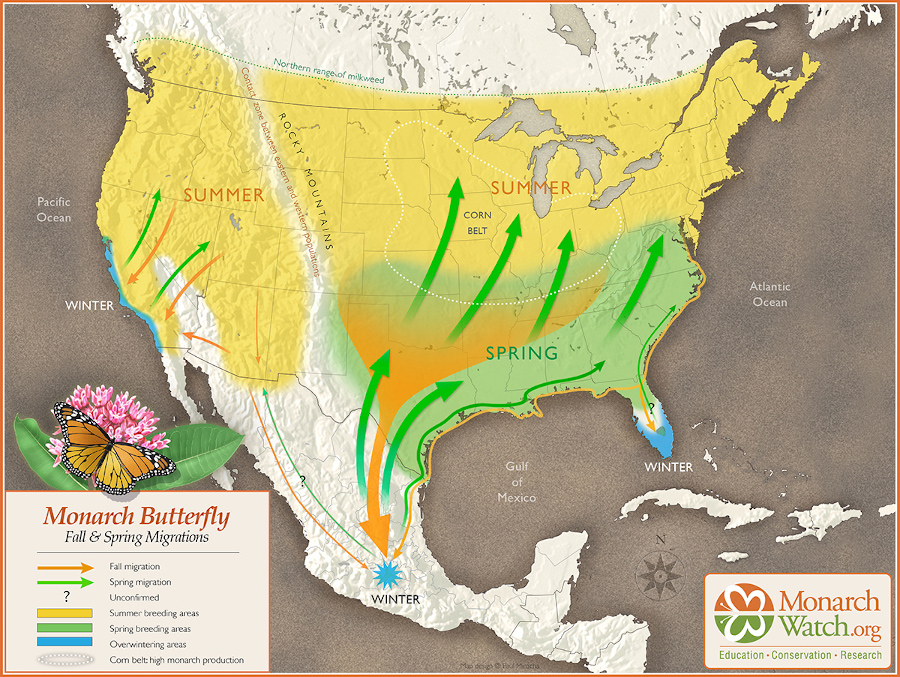
Monarch butterflies travel up to thousands of kilometers as part of their seasonal migrations. To navigate over these large distances, they are aided by a time-compensated sun compass sense. (Credit: Paul Mirocha / MonarchWatch.org. Fair use.)
Journey Into Minds
Knowing how animals find their way across vast distances may seem like a problem of elimination. Given an animal’s ability to see, smell, listen, feel, or sense, which sensory inputs actually matter for a long-distance journey? To test competing hypotheses, animals are deprived of vision or smell, displaced, confused with false sensory inputs, placed in funnels, tagged, tracked, and sometimes even mutilated.
One pattern that emerges from the many experiments described by Barrie is that animal minds—even those of insects—are complex, and animals often make the best use of all navigational information available to them. A subtle change in geomagnetic inclination may be no less important than the smell of coastal vegetation, the direction of the wind, or the movement of stars around the Northern Star.
Towards the end of the book, Barrie briefly criticizes the long history of anthropocentrism in biology, which essentially reduced animals to stimulus-response robots categorically distinct from humans. He reminds us that we are animals, and appeals to us to not let our own navigational skills atrophy. Becoming literate in the “language of the Earth” is a way for us to remain connected to our planet, and to treasure the richness of life on it.
The Verdict
Supernavigators made me say “wow” out loud a few times as I read it; this is testament both to the fascinating subject matter, and Barrie’s ability to convey it. I appreciated the simple sketches that illustrate some navigational concepts, and the brief anecdotes at the end of each chapter that are meant to show how little we still know about animal navigation. While the book would have benefited from some more synthesis and a bit less repetition, if you are interested in the subject, I don’t think you’ll be disappointed. 4.5 stars, rounded up.
You are Maxine “Max” Caulfield. You are 18 years old. You live in Arcadia Bay, a seaside town in the US state of Oregon. You’re a student at a private high school with an arts and science focus. No matter whether you’re at school, at home, or at play, you and your Polaroid camera as inseparable. Perhaps one day your pictures will catch the eye of Mark Jefferson, a famous photographer who teaches at your school?
This is the seemingly ordinary setting of Life is Strange, a narrative adventure game developed by Dontnod Entertainment and published episodically through 2015. The game is played in a third-person 3D view, rendered in an artistic style situated firmly between painterly and photorealistic. While not up to today’s technical standards, the game world is still beautiful and immersive.
Your experience as Max starts with a nightmarish vision of destruction. But it was only a daydream; you’re in school, and Mr. Jefferson is asking you about the technical process that gave rise to the first photographic self-portraits. It’s only after a dramatic encounter with a childhood friend, Chloe Price, that things really get strange. And what is the story behind the disappearance of Chloe’s friend, Rachel Amber?
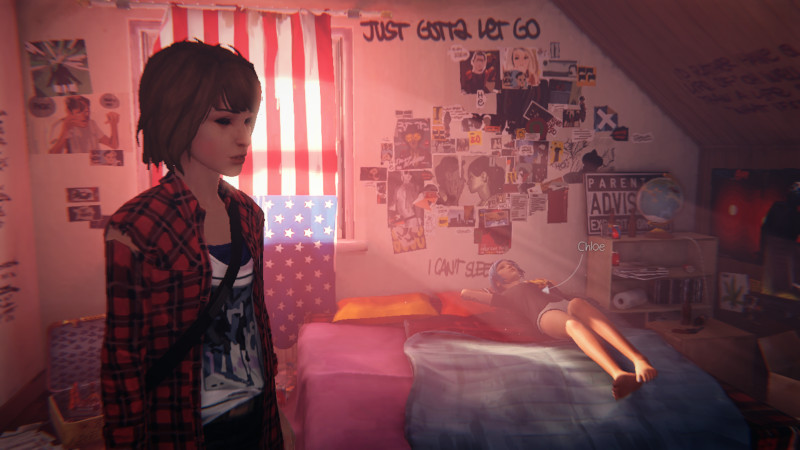
Max in Chloe’s room. The game lets you explore its rich environments at your own pace, taking in every detail if you want to. (Credit: Dontnod Entertainment. Fair use.)
In terms of gameplay, Life is Strange has much in common with classic point-and-click adventure games: You spend a lot of your time exploring, talking to other characters, and solving small puzzles. There’s no unlimited inventory—occasionally a puzzle may involve finding an object and carrying it from one location to another. There is one additional game mechanic (spoilers ahead):
Warning: The text below contains spoilers.
You discover early in the game that you have a limited ability to reverse the flow of time. This often allows you to try different decision paths and compare outcomes. It makes for a world that feels real and responsive (decisions have consequences) without painting you into a corner.
The game is fully voiced, and it’s a joy to poke at objects in the environment and listen to Max reflect on what she sees in the world around her. If you sit down on a bench, you may be rewarded with some additional wide angle camera views and narration. If you prefer to rush through the story, you can do that, too.
Life is Strange is not a perfect game (some scenes overstay their welcome, for example), but I still consider it a masterpiece in interactive storytelling. It’s a joy to explore Arcadia Bay, thanks to the excellent art direction and attention to detail. The wonderful chemistry between Max and Chloe invests the player in both characters.
The first episode of the game is available for free, and you can often pick the whole game up for under $5. Thanks to Feral Interactive, there is an excellent Linux port, as well. If your computer is not a potato and you enjoy narrative adventure games, Life is Strange is one title you won’t want to miss.
Das Miniatur-Wunderland ist nicht einfach nur “Mal-eben-Eisenbahn-schauen”, sondern man merkt an allen Ecken und Enden dass das Team rund um die beiden Macher hier jede Menge Herzblut einfließen lässt. Das geht los bei den unzähligen Taster-Aktionen und endet bei den ganzen versteckten Kleinigkeiten auf der kompletten Anlage. Da geraten die Züge schon fast zur Nebensächlichkeit. Und das will bei einer Modelleisenbahnaalage schon etwas heißen.

Feuerwehr- und Polizeieinsatz an einem Fluß auf der Miniatur-Wunderland Anlage (Eigenes Werk. Lizenz: CC-BY-SA.)

Ausblick auf ein Bahnhofsdiorama in der Anlage (Eigenes Werk. Lizenz: CC-BY-SA.)
Muss ich hier noch mehr schreiben? Ich glaube nicht, denn der Ruf eilt dem Miniatur-Wunderland weit voraus und ist gerechtfertigt. Nur die kleine Kantine, anders würde ich das Restaurant nicht bezeichnen, ist ein kleiner Ausreißer aber kann die Wertung für die Anlage nicht schmälern. Pommes, Schnitzel und Co. gibt es woanders besser aber für den kleinen Hunger ist es O.K.

Nächtlicher Ausblick auf einen kleinen Bahnhof innerhalb der Anlage (Eigenes Werk. Lizenz: CC-BY-SA.)
Schön, neu und informativ sind die drei Schlagworte, die ich für diesen tollen Baumwipfelpfad vergeben würde. Mit einer sehr moderaten Steigung und einer angenehmen Länge ist er für fast alle Besucher geeignet. Unterwegs sind an jeder Plattform Informationstafeln aufgestellt , die über den Wald und seine Bewohner informieren. Und man erhält auch einen Blick von oben in den angrenzenden Wildtierpark. Sehr schön.

Am Anfang des Pfades (Eigenes Werk. Lizenz: CC-BY-SA.)
Auf dem abschließendem, 40 Meter hohen Turm erhält man einen guten Rundumblick auf die nördliche Lüneburger Heide. Dieser ist für mobilitätseingeschränkte Personen mit einem Lift erreichbar.

Der Turm mit Aussichtsplattform (Eigenes Werk. Lizenz: CC-BY-SA.)
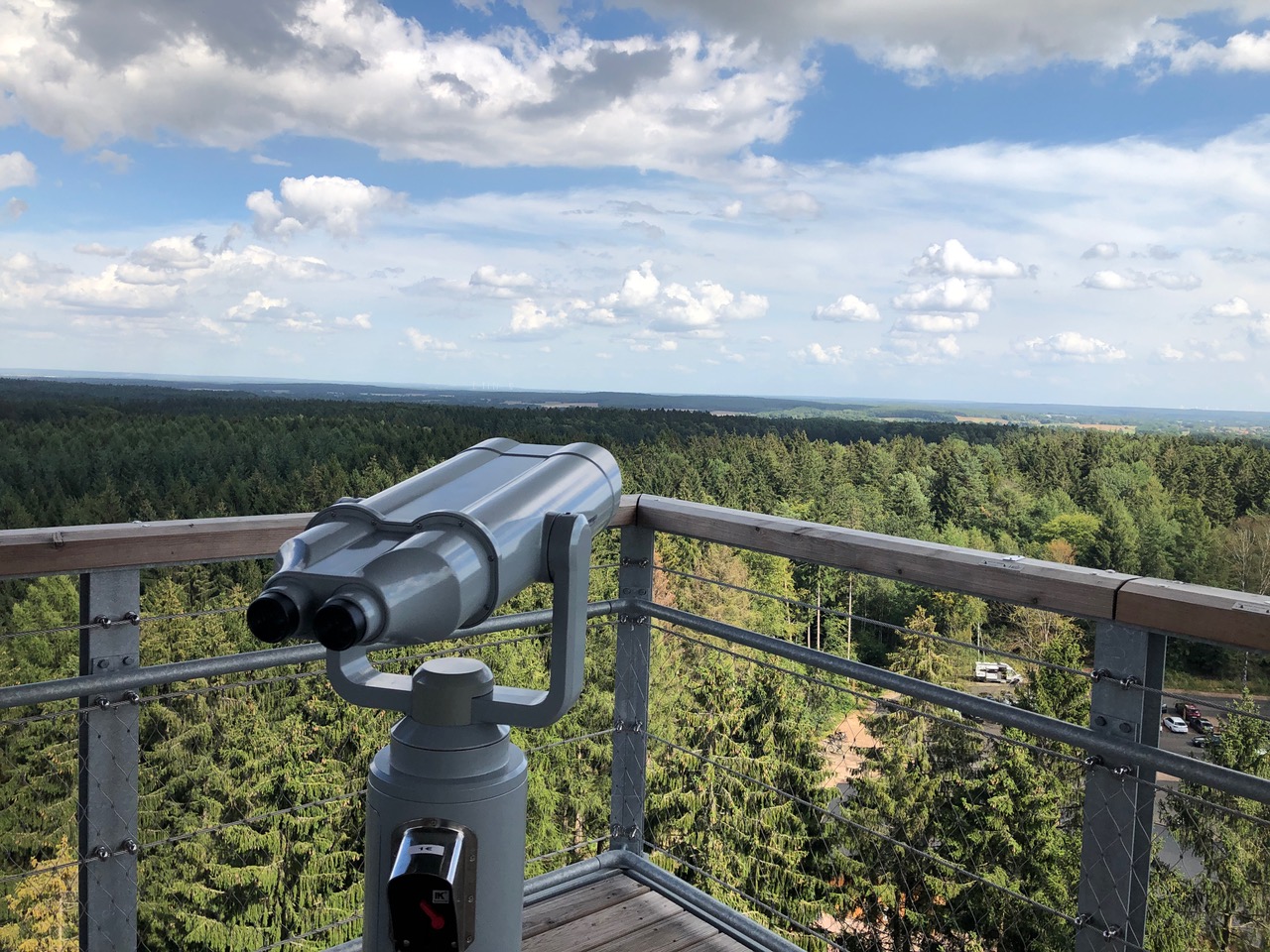
Aussicht vom Turm auf die Nordheide (Eigenes Werk. Lizenz: CC-BY-SA.)
Abschließend kann man sich im Café noch mit einer kleinen Stärkung versorgen.
Alles in allem ein lohnenswertes Ausflugsziel.
FTL: Faster Than Light is now more than 8 years old, but it looked outdated when it was released. Start up the game, and you’re greeted by a low-resolution “LOADING” font, followed by a static title screen featuring a fleet of spaceships parked ominously in front of a planet. The first hint that this game has hidden depths is its memorable title theme, wonderfully evocative of the quietude of space.
The story is told in the simplest terms: You command a lone federation starship that is on the run from the malignant Rebellion (think US Civil War rebels, not Star Wars rebels). Your faster-than-light drive lets you make jumps from one galactic beacon to the next, through several sectors of space that are newly generated on each playthrough. You’re trying to reach the last stronghold of the federation, in order to defeat the Rebel Flagship that’s threatening to destroy it.
Almost every galactic beacon holds a story, or part of one: you run into slavers, traders, pirates, and rebels; you rescue raving madmen and space colonists; you find weaponry and treasure. You often get to make choices, with randomized outcomes. (Stay clear of the Giant Alien Spiders until you know what you’re doing; they are no joke.) At first these scenarios may seem repetitive, but your options will increase depending on your ship and crew.
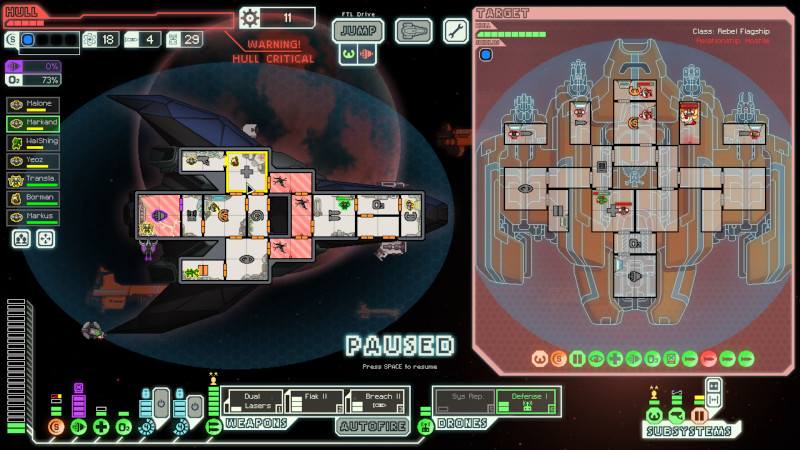
We’re about to get blown to bits by the rebel flagship. (Credit: Subset Games. Fair use.)
Space War!
Many encounters turn into ship-to-ship battles, and that’s where the game really shows its genius. Combat takes place in a real-time-with-pause system that allows you to plan your every move, or to shoot from the proverbial hip. Planning is often advisable, as you may find yourself at a disadvantage even in early encounters.
Each of your ship systems matters, and so does each of theirs. Do they have teleporters, which they’ll use to board your ship and fight your crew? Are you able to hack into their systems, maybe sabotage their shields or their cloaking device? Do they have a flak weapon that will shower your ship with debris? Can you use that asteroid field in your favor?
Some battles are unwinnable (given enough time, you can try to jump away), others will only seem that way to the new player. But it’s almost always fun to figure out what you can do with the cards you’ve been dealt, and to master the ship you’ve chosen to command. There are 10 ships to unlock, and different layouts for each, demanding very different styles of play.
There’s more that could be said about the game’s systems, from ship upgrades to crew recruitment and experience, from drone warfare to oxygen management. In its totality, the game really makes you feel like you’re commanding the crew of a spaceship, and your imagination fills in what the simple graphics cannot.
Death Without Friction
From this description and from screenshots, FTL may appear like a dauntingly complicated game, but this is where the game’s second core strength lies: an absolutely delightful user experience. Move your mouse across the screen, and you’ll get helpful explanations; keyboard and mouse shortcuts are readily available for everything you need often.
How do you increase or decrease the power for the shield systems? In many games, you’d have to click a “+” and “-” button, or drag a slider; in FTL, you left-click to increase, right-click to decrease, or use a keyboard shortcut. And so it is with the rest of the UI: easy to learn, quick to repeat.
I’m a big fan of NetHack (one of the early games that gave us the term “roguelike”), and FTL is the closest equivalent with a space opera setting that I have encountered. The low-friction user experience is a huge part of what makes it all work—it allows you to focus on story and strategy, instead of mechanics that get increasingly annoying through repetition.
Every roguelike tends to claim that “losing is part of the fun”, and in the case of FTL, it’s usually true. Except for when you’re getting hammered by pirates while solar flares are lighting every part of your ship on fire, for the 15th time…
The Verdict
5 stars, no contest. I honestly can’t say enough good things about FTL—it’s a masterpiece of indie game development that has made developer Subset Games an industry legend (their second game, Into the Breach, is very different but no less luminous). The native Linux version works beautifully, and the game is available in 10 languages. There are also amazing-looking mods, but I have not tried them yet.
Even at $10 on GOG, the game offers excellent value (as of this writing, I’ve put some 100 hours of play into it) but it regularly goes on sale for far less. Be aware that this isn’t a fair game—as with most roguelikes, the RNG will put you in impossible situations—and if that tends to prevent you from having fun, you may want to avoid it. For everyone else, FTL continues to be a beacon calling us to assist the federation, just one more time.
Beth Harmon ist ein Schachgenie im Amerika der 1960er und 70er Jahre. Doch damit nicht genug, um diesen Charakter als Außenseiter darzustellen. Sie ist ein Waisenkind, welches in eine zerrüttete Familie adoptiert wird und mit einer Tablettensucht zu kämpfen hat. Klingt sehr Klischeebeladen aber ist durchaus sehr unterhaltsam.
Das Schachspiel lernt sie beim Schulhelfer im Keller und erlangt durch ihr gnadenloses Schachspiel schnell Berühmtheit über das Waisenhaus hinaus. Auch die Spieler des örtlichen Schachclubs sind schnell ausgespielt und die große weite Welt wartet.
Warnung: Der untenstehende Text enthält Spoiler.
Über verschiedene größere Turniere gelangt Beth nach Russland um gegen den Großmeister anzutreten, gegen den sie in einem früheren Spiel verloren hatte.
Die Serie dreht sich hauptsächlich um Beth und die weiteren Darsteller verblassen neben ihr. Ein gewöhnungsbedürftiger Erzählstil aber das macht nichts, denn die Serie ist nur eine Staffel mit sieben Episoden lang. Genau richtig, um diese Serie an einem Tag zu schauen.
Fazit
Gelungene Unterhaltung innerhalb eines Handlungsrahmens der ansonsten in meinem Umfeld keine Rolle spielt. Dafür bietet die Serie eine sehr gute Unterhaltung und lohnt dafür schon den Monatsbeitrag bei Netflix wert.
What’s in a game? Is it that you have to click the right button at the exact right moment? Or that it transports you to another world? Mutazione is firmly in the latter category—a narrative adventure with no action sequences and barely a puzzle in sight, but with a world that comes alive with ambience and the characters that inhabit it.

The world of Mutazione is a joy to explore, even if the overall experience is very linear. (Credit: Die Gute Fabrik. Fair use.)
Mutazione is also the name of the island where most of the game takes place. It’s a place implausibly forgotten by the rest of civilization; an island whose flaura and fauna (including its human inhabitants) have been transformed by a meteor impact many years ago. You play as Kai, a teenage girl who visits her sick grandfather on the island, and in the process becomes immersed in its past, present, and future.
Much of the gameplay consists of Kai walking from place to place (or person to person), occasionally performing simple fetch quests to advance the plot. Dialog (which isn’t voiced) gives you limited choices, such as the option to crack a joke in response to someone else’s remark, or to remain silent.
Gardening With Feeling
Each game day is broken into segments, and you decide when to advance from morning to noon, from afternoon to evening. As the game time advances, so do the game’s little subplots, including a fair bit of soap opera about love relationships that are burgeoning or that seem to be falling apart.
It soon becomes clear, with her grandfather’s help, that Kai has a gift for gardening in Mutazione’s unusual ecology, where music, emotion, and plant growth seem to be inextricably connected. Throughout the game, you will collect seeds and cultivate gardens situated in different microclimates. If you fear or hope that there’s a challenging mini-sim hidden inside the game, it’s not so: the gardening parts of the game are meditative and creative, not difficult.
A “garden mode” is unlocked after you complete the story, which lets you experiment to your heart’s content. Or so I’m told—in the Linux version, the mode never appeared for me after I finished the game.
The Verdict
Mutazione is undeniably gorgeous. The art direction is simply stellar, from beautifully drawn abandoned buildings, to chickens scattering as you approach them, to spear-wielding, sentient dots refusing to let you enter their habitat. The soundtrack is great, too, and when the island band performs a song in the local bar, you can imagine that you’re right there with the mutants.
The plot is largely coherent, but much of the game is about making emotional connections. The characters of Mutazione have their own fears and ambitions; they don’t exist to help the player reach some goal, but they do make Kai feel welcome in this world that is as new to her as it is to us.
I would give the game 4.5 stars, rounded up. If you enjoyed Oxfenfree but found its spooky story a little bit stressful, you’re likely to love Mutazione. The only thing I missed is a sense that I had control over where the story was headed, or at least a final game-defining choice. Narrative designer and writer Hannah Nicklin has described the game as having “multiple middles” instead of multiple endings, and that’s true—there’s enough to uncover, at least, to justify a second playthrough. In any event, the first playthrough is well worth the price of admission.
